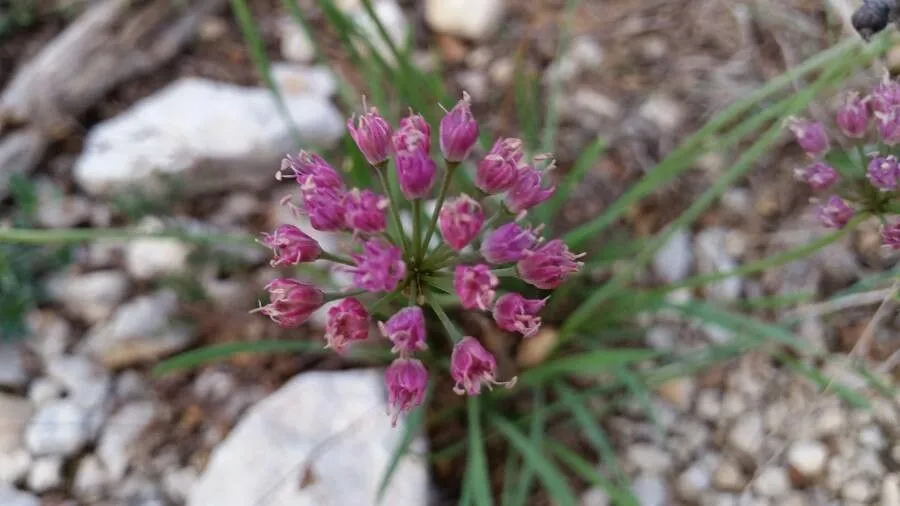
Author: L.
Bibliography: Sp. Pl.: 299 (1753)
Year: 1753
Status: accepted
Rank: species
Genus: Allium
Vegetable: Unknown
Observations: Siberia to Korea
German garlic, scientifically known as Allium senescens, is a resilient and versatile member of the Amaryllidaceae family. First described in 1753 by the renowned botanist Carl Linnaeus in his seminal work “Species Plantarum”, this plant has earned its place not only in the annals of botanical history but also in gardens and kitchens around the world.
Native to a range extending from Siberia to Korea, German garlic thrives in temperate climates, showcasing its adaptability across various habitats. This perennial plant is particularly valued for its ornamental qualities and culinary uses. Its distinctive, slightly flattened, strap-like leaves grow in a rosette pattern and emit a mild garlicky aroma when crushed, making it a subtle yet flavorful addition to a variety of dishes.
German garlic is noted for its attractive, spherical clusters of pale purple to lilac flowers that bloom in mid to late summer. These blossoms not only add a splash of color to gardens but also attract pollinators such as bees and butterflies, contributing to the ecological health of the environment.
Cultivating German garlic is relatively straightforward, making it a popular choice for both novice and experienced gardeners. It prefers well-drained soil and full sun to partial shade, demonstrating a robust tolerance for a range of soil conditions. Once established, German garlic is known for its low maintenance needs and longevity, often forming dense clumps that can be divided to propagate new plants.
In addition to its horticultural appeal, German garlic has a place in the culinary world. The leaves can be used fresh in salads, soups, and stews, imparting a delicate garlic flavor without the pungency of common garlic cloves. Additionally, its flowers are edible and can serve as a decorative and flavorful garnish.
Overall, Allium senescens or German garlic stands out as a multifaceted plant that is appreciated for its ornamental beauty, ease of cultivation, ecological benefits, and culinary versatility. Whether utilized in garden landscapes or kitchen creations, it continues to be a beloved plant among many enthusiasts.
Deu: berg-lauch
Eng: german garlic, broadleaf chives
Swe: bredbladig kantlök
En: German garlic, Broadleaf chives, Broad-leaved Chives
Ca: All columbí
Zh: 山韭
Cs: Česnek šerý
Et: Rauklauk
Fi: Vaarinlaukka
De: Berg-Lauch
Is: Fjallalaukur
Ko: 두메부추
Pl: Czosnek skalny
Ru: Luk Stariushchii, Лук стареющий
Sv: Bredbladig kantlök, Kantlök
Taken Aug 15, 2020 by Sarami (cc-by-sa)
Taken Aug 8, 2019 by The Raven Girl (cc-by-sa)
Taken Jun 24, 2020 by Рафаэль (cc-by-sa)
Taken Jul 15, 2009 by Photoflora – Benoit BOCK (©)
Taken Aug 8, 2019 by The Raven Girl (cc-by-sa)
Taken Aug 10, 2021 by pavel.a (cc-by-sa)
Taken Jul 24, 2020 by Caroline Blacketter (cc-by-sa)
Taken Mar 21, 2011 by Tela Botanica − Liliane Roubaudi (cc-by-sa)
Taken Jun 30, 2022 by ben vc (cc-by-sa)
Taken Sep 26, 2018 by Antonio Rey (cc-by-sa)
Taken May 10, 2022 by Rainer Roth (cc-by-sa)
Taken Jul 23, 2021 by Marjan Boonen (cc-by-sa)
Taken Jul 16, 2020 by Patrick van Drunen (cc-by-sa)
Taken Jul 28, 2020 by Pedrocchi César (cc-by-sa)
Taken Oct 16, 2022 by Bernard Paques (cc-by-sa)
Taken Aug 1, 2021 by Dieter Albrecht (cc-by-sa)
Family: Myrtaceae Author: (F.Muell.) K.D.Hill & L.A.S.Johnson Bibliography: Telopea 6: 402 (1995) Year: 1995 Status:…
Family: Rubiaceae Author: Pierre ex A.Froehner Bibliography: Notizbl. Bot. Gart. Berlin-Dahlem 1: 237 (1897) Year:…
Family: Sapindaceae Author: Koidz. Bibliography: J. Coll. Sci. Imp. Univ. Tokyo 32(1): 38 (1911) Year:…
Family: Asteraceae Author: A.Gray Bibliography: Pacif. Railr. Rep.: 107 (1857) Year: 1857 Status: accepted Rank:…
Family: Fabaceae Author: Medik. Bibliography: Vorles. Churpfälz. Phys.-Ökon. Ges. 2: 398 (1787) Year: 1787 Status:…
Family: Aspleniaceae Author: (Cav.) Alston Bibliography: Bull. Misc. Inform. Kew 1932: 309 (1932) Year: 1932…